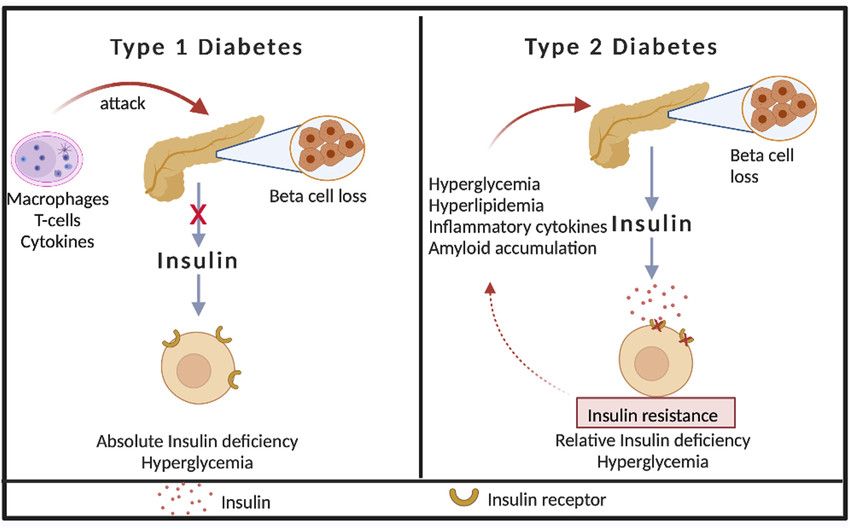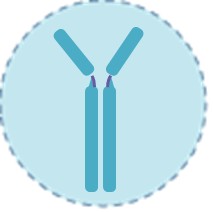Type 1 diabetes (T1D) is an autoimmune disorder characterized by the destruction of insulin-producing β-cells, leading to lifelong dependence on exogenous insulin. Accurate and early diagnosis is critical to prevent acute complications like diabetic ketoacidosis and mitigate long-term vascular damage. This resource explores the integral role of advanced serological testing, including autoantibody panels (e.g., GADA, IA-2A, ZnT8A) and c-peptide quantification, in confirming autoimmune etiology, differentiating T1D from other diabetes types, and guiding therapeutic decisions.
Overview of Type 1 Diabetes
Type 1 diabetes (T1D) is a chronic autoimmune disorder characterized by the immune-mediated destruction of insulin-producing pancreatic β-cells, leading to absolute insulin deficiency. It typically presents with acute symptoms of hyperglycemia, such as polyuria, polydipsia, unexplained weight loss, and fatigue, and requires lifelong insulin therapy. Diagnosis relies on confirming hyperglycemia alongside evidence of autoimmunity (e.g., autoantibodies against GAD, IA-2, or insulin) and/or functional insulin deficiency (e.g., low C-peptide levels). While often diagnosed in childhood or adolescence, T1D can occur at any age and necessitates rigorous monitoring to prevent acute complications like ketoacidosis and long-term vascular damage.
 Fig.1 Pathogenesis of type 1 and type 2 diabetes. (Khin P P, et al., 2023)
Fig.1 Pathogenesis of type 1 and type 2 diabetes. (Khin P P, et al., 2023)
Clinical Suspicion and Initial Tests of Type 1 Diabetes
Clinical suspicion for type 1 diabetes (T1D) arises from acute symptoms such as rapid weight loss, polyuria, polydipsia, fatigue, and blurred vision, often accompanied by a history of autoimmune conditions or family history. Initial diagnostic steps focus on confirming hyperglycemia through fasting plasma glucose (≥126 mg/dL), random plasma glucose (≥200 mg/dL with symptoms), or glycated hemoglobin (HbA1c≥6.5%). While these tests establish glucose dysregulation, they cannot differentiate T1D from other diabetes types, necessitating further serological and functional testing for definitive diagnosis.
Key Autoantibodies for Type 1 Diabetes Diagnostics
In type 1 diabetes (T1D), autoantibodies serve as critical serological markers of ongoing autoimmune destruction of pancreatic β-cells. Their detection confirms the autoimmune etiology of the disease, distinguishes T1D from other diabetes types (e.g., type 2 diabetes, MODY), and enables early diagnosis, sometimes even before clinical symptoms manifest. The presence of multiple autoantibodies significantly increases the risk of progressing to overt diabetes. The most clinically relevant autoantibodies include:
Glutamic Acid Decarboxylase Autoantibodies (GADA)
Target the enzyme GAD65. Most common and often first detected in T1D, with high sensitivity across all age groups. Persist long after diagnosis.
Insulinoma-Associated-2 Autoantibodies (IA-2A)
Target tyrosine phosphatase-like protein IA-2. Exhibit high specificity for T1D and are strongly associated with rapid β-cell decline and progression to clinical disease.
Insulin Autoantibodies (IAA)
Target endogenous insulin. Most prevalent in young children (<5 years) and often the first antibody to appear in early-onset T1D. Less common in adults.
Zinc Transporter 8 Autoantibodies (ZnT8A)
Target a β-cell-specific zinc transporter. Add diagnostic value in autoantibody-negative cases and help improve overall sensitivity, especially in recent-onset T1D.
Testing for these antibodies, typically via ELISA, radioimmunoassay (RIA), or electrochemiluminescence (ECL), is essential for differentiating T1D from other forms of diabetes, identifying pre-symptomatic at-risk individuals (e.g., family members of T1D patients), and supporting enrollment in prevention trials. The combination of multiple autoantibodies (>2) confers nearly 100% risk of developing clinical T1D over time.
C-Peptide: The Functional Measure of Insulin Secretion
C-Peptide is a stable peptide fragment cleaved during the conversion of proinsulin to insulin in pancreatic β-cells. Its measurement serves as a direct and reliable biomarker of endogenous insulin secretion, providing critical insights into pancreatic β-cell function. Unlike insulin, c-peptide has a longer half-life and exhibits minimal hepatic extraction, making it a more stable indicator for clinical assessment. The clinical applications of c-peptide are as follows:
- Differentiating Diabetes Types: C-peptide levels effectively distinguish autoimmune Type 1 diabetes (low/absent) from insulin-resistant Type 2 diabetes (normal/elevated).
- Assessing Disease Progression: Declining c-peptide levels quantitatively reflect β-cell functional loss and disease advancement in both Type 1 and Type 2 diabetes.
- Guiding Therapy: Low c-peptide levels mandate insulin therapy, while preserved levels may support alternative treatments or participation in preservation trials.
The Evolving Landscape for Type 1 Diabetes Diagnostics
The future of type 1 diabetes (T1D) diagnostics is shifting toward pre-symptomatic prediction and staging, leveraging multiplex autoantibody panels and genetic risk scores to identify at-risk individuals years before clinical onset. Advanced technologies like electrochemiluminescence assays enhance detection sensitivity, while integration with C-peptide kinetics and emerging biomarkers (e.g., T-cell assays, miRNA signatures) aims to refine prognostic accuracy. This paradigm enables early intervention opportunities, from immune therapies to lifestyle modifications, fundamentally transforming T1D management from reactive treatment to proactive prevention.
Alta DiagnoTech delivers comprehensive and precise IVD solutions for type 1 diabetes (T1D) management, including autoantibody assays, C-peptide tests, and advanced monitoring tools to guide personalized care. If you have related needs, please feel free to contact us for more information or product support.
Reference
- Khin P P, Lee J H, Jun H S. Pancreatic beta-cell dysfunction in type 2 diabetes[J]. European Journal of Inflammation, 2023, 21: 1721727X231154152.
This article is for research use only. Do not use in any diagnostic or therapeutic application.



 Fig.1 Pathogenesis of type 1 and type 2 diabetes. (Khin P P, et al., 2023)
Fig.1 Pathogenesis of type 1 and type 2 diabetes. (Khin P P, et al., 2023) 



